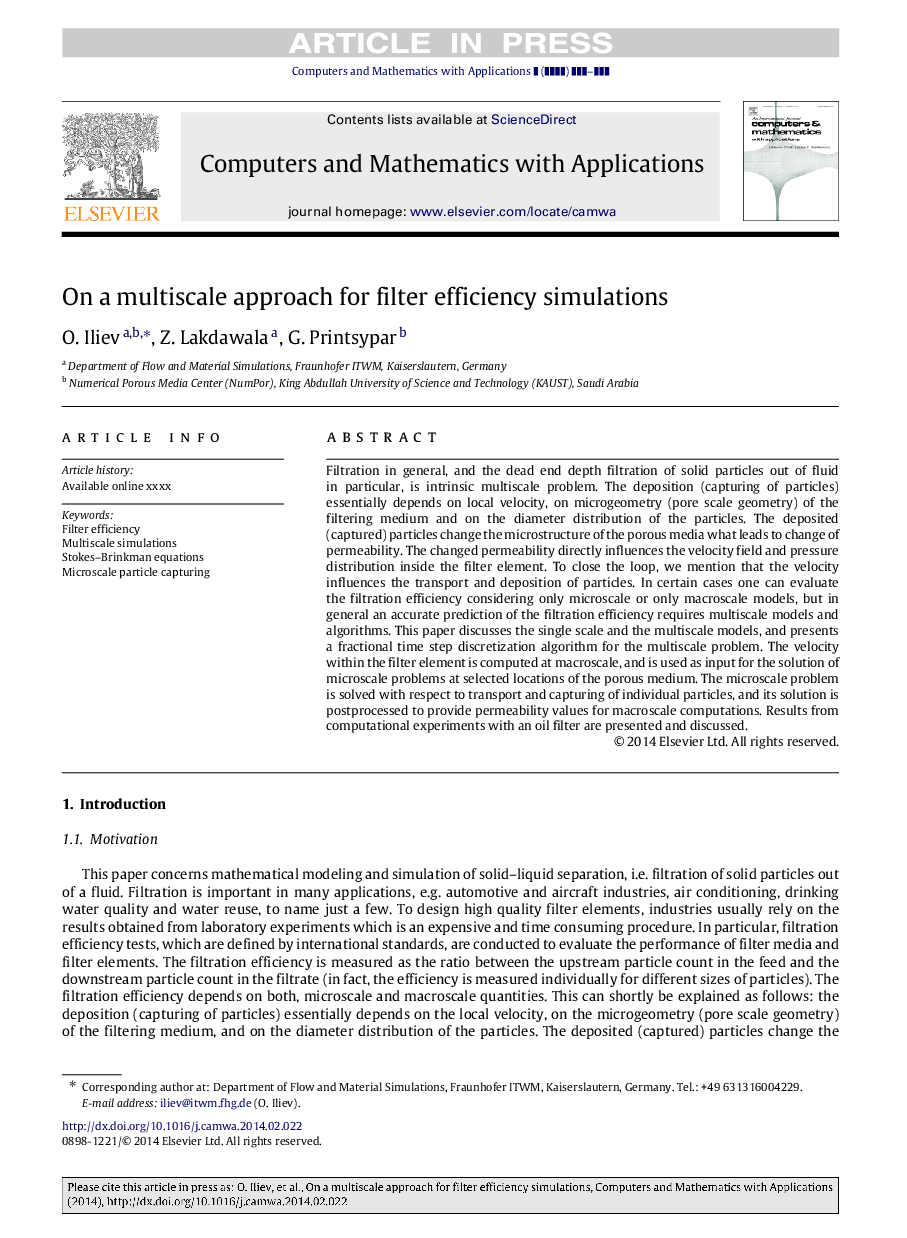| کد مقاله | کد نشریه | سال انتشار | مقاله انگلیسی | نسخه تمام متن |
|---|---|---|---|---|
| 10346135 | 698720 | 2014 | 14 صفحه PDF | دانلود رایگان |
عنوان انگلیسی مقاله ISI
On a multiscale approach for filter efficiency simulations
ترجمه فارسی عنوان
در یک روش چند منظوره برای شبیه سازی کارایی فیلتر
دانلود مقاله + سفارش ترجمه
دانلود مقاله ISI انگلیسی
رایگان برای ایرانیان
کلمات کلیدی
کارایی فیلتر، شبیه سازی چند بعدی، استوکس معادلات برینکمن، ذرات میکروسکوپ،
ترجمه چکیده
به طور کلی فیلتراسیون و فیلتر کردن عمق مرده از ذرات جامد به طور خاص از مایع به طور خاص، مسئله چند هسته ای ذاتی است. رسوب (جذب ذرات) اساسا به سرعت محلی، بر روی میکروژومتری (هندسه حفره مقیاس) محیط فیلتر و بر روی توزیع قطر ذرات بستگی دارد. ذرات ذخیره شده (رب)، میکروساختار رسانه متخلخل را تغییر می دهند که منجر به تغییر نفوذپذیری می شود. نفوذ پذیری تغییر شده به طور مستقیم بر میدان سرعت و توزیع فشار داخل عنصر فیلتر تاثیر می گذارد. برای بستن حلقه، ما اشاره می کنیم که سرعت انتقال و انباشت ذرات را تحت تاثیر قرار می دهد. در بعضی موارد می توان کارآیی تصفیه را با توجه به مدل های میکروسکوپ یا فقط مدل های ماکروسکال ارزیابی کرد، اما به طور کلی پیش بینی دقیق از کارایی تصفیه نیاز به مدل های چند متغیره و الگوریتم ها دارد. این مقاله مقادیر تک و مدل های چند بعدی را مورد بحث قرار می دهد و یک الگوریتم گسسته گام به گام را برای مسئله چند بعدی ارائه می دهد. سرعت درون عنصر فیلتر در مقیاس ماکروسکوپ محاسبه می شود و به عنوان ورودی برای حل مسائل میکروسکوپ در نقاط انتخاب شده از محیط متخلخل مورد استفاده قرار می گیرد. مشکل میکروسکوپ با توجه به انتقال و جذب ذرات فرد حل شده است و راه حل آن پس پردازش می شود تا مقادیر نفوذ پذیری برای محاسبات ماکروسکال ارائه شود. نتایج حاصل از آزمایش های محاسباتی با یک فیلتر روغن ارائه و مورد بحث قرار می گیرد.
موضوعات مرتبط
مهندسی و علوم پایه
مهندسی کامپیوتر
علوم کامپیوتر (عمومی)
چکیده انگلیسی
Filtration in general, and the dead end depth filtration of solid particles out of fluid in particular, is intrinsic multiscale problem. The deposition (capturing of particles) essentially depends on local velocity, on microgeometry (pore scale geometry) of the filtering medium and on the diameter distribution of the particles. The deposited (captured) particles change the microstructure of the porous media what leads to change of permeability. The changed permeability directly influences the velocity field and pressure distribution inside the filter element. To close the loop, we mention that the velocity influences the transport and deposition of particles. In certain cases one can evaluate the filtration efficiency considering only microscale or only macroscale models, but in general an accurate prediction of the filtration efficiency requires multiscale models and algorithms. This paper discusses the single scale and the multiscale models, and presents a fractional time step discretization algorithm for the multiscale problem. The velocity within the filter element is computed at macroscale, and is used as input for the solution of microscale problems at selected locations of the porous medium. The microscale problem is solved with respect to transport and capturing of individual particles, and its solution is postprocessed to provide permeability values for macroscale computations. Results from computational experiments with an oil filter are presented and discussed.
ناشر
Database: Elsevier - ScienceDirect (ساینس دایرکت)
Journal: Computers & Mathematics with Applications - Volume 67, Issue 12, July 2014, Pages 2171-2184
Journal: Computers & Mathematics with Applications - Volume 67, Issue 12, July 2014, Pages 2171-2184
نویسندگان
O. Iliev, Z. Lakdawala, G. Printsypar,
